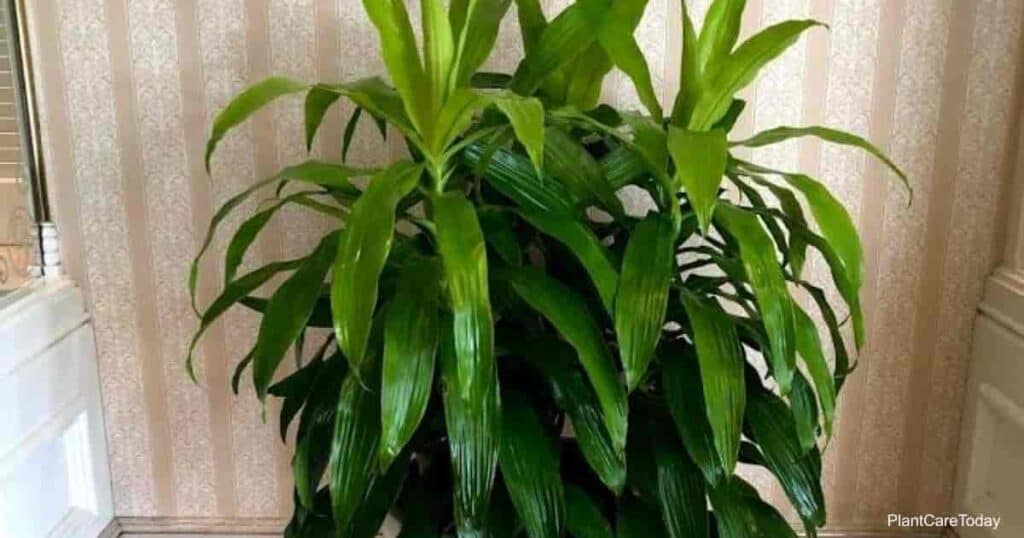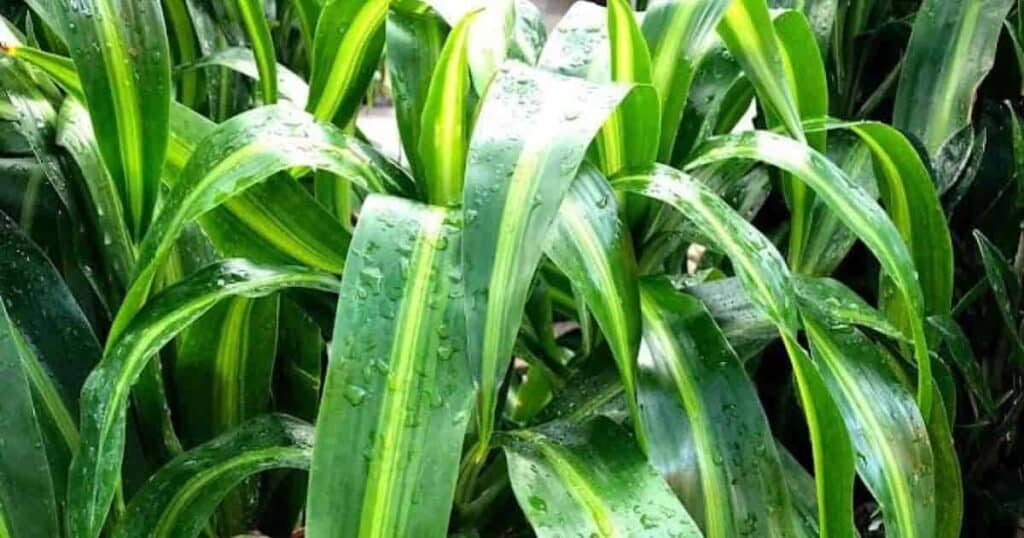All types of Dracaena plants grow in very similar conditions to survive and thrive.

Dracaenas like:
- Consistent, moderate humidity
- Moist soil (not wet)
- Bright indirect sunlight
- Monthly fertilizing from early spring through mid-autumn
If any of these conditions are lacking, your Dracaena may suffer, including dracaena brown tips and dracaena yellow leaves.
There are many reasons why your dracaena leaves turning yellow, and if not addressed promptly, the problem may worsen.
This article will look at the causes of brown or yellow leaves in Dracaena plants.
We share 9 tips to help you diagnose and answer “Why is my Dracaena leaves turning yellow and brown“?
- Older Leaves Turn Yellow Naturally
- Dry Air Damages Leaves On A Dracaena Plant
- Dracaenas Do Not Like Sudden Temperature Changes
- Cold, Soggy Potting Mix Causes Leaves to Die
- Overwatering Causes Fungal Infections
- Underwatering Causes Crispy Leaves
- Poor Water Quality Causes Yellow/Brown Leaves
- Salt Buildup Causes Yellow/Brown Leaves
- Pest Infestation is Common with Yellow/Brown Leaves
Older Leaves Turn Yellow Naturally
One very simple reason for your question, Why are my dracaena leaves turning brown and yellow, is age. As a plant like a Dracaena fragrans matures and grows taller, the lower leaves naturally mature and drop off.
When this happens, use sharp scissors to trim them off trim or pull them away. Fresh new growth replaces the old leaves at the top of the plant.
Dry Air Damages Leaves On A Dracaena Plant
If the air is too dry, you will likely see browning leaf tips and yellowing margins in the new foliage of your Dracaena plants. Loss of leaves is sure to follow.
You can deal with this problem by putting your Dracaena or corn plant on a pebble tray filled with water.
- Set the plant on top of the pebbles
- Be careful not to let the water touch the bottom of the pot
- As the water evaporates, it increases the humidity level surrounding your plant.
Besides the use of a pebble tray, you can mist your plant on a daily basis. Setting up a humidifier in the room will also remedy dracena yellow leaves.
Dracaenas Do Not Like Sudden Temperature Changes
Another big cause of dragon plant yellow leaves is a lack of proper care or exposure to cold drafts. Moreover, Dragon tree leaves turning yellow is a sign of temperature stress.
Dracaena likes a consistently warm temperature of 70° to 80° degrees Fahrenheit at all times.
In the spring and autumn, nighttime temperatures can drop significantly. Your plant may be happy near an open window through the summertime.
But you may want to move it away or close the window at night during cold weather.
Dracaena marginata yellow leaves can also indicate that your plant is not getting enough light, while dracaena brown leaves could indicate it is getting too much.

Cold, Soggy Potting Mix Causes Leaves to Die
Chilly temperatures combined with overwatering tend to encourage bacterial and fungal diseases.
These conditions can lead to dragon tree brown tips, or dracaena leaves turning yellow and falling off.
Read: How Often To Water Dracaena Plants
One way to prevent this is by allowing the excess water to drain from the drainage hole at the bottom of the pot and into the saucer.
If your plant is suffering from an infection, you may notice damp, mushy areas on the leaves. In some cases, blisters may develop. These are all signs of a malady known as a leaf spot.
You can address dracaena turning yellow by pruning away damaged parts of the plant. You may want to repot in fresh soil as a last resort. Be sure the container has ample drainage holes.
Move your Dracaena marginata plant (dragon tree) to an area with the following:
- Better lighting
- A higher temperature
- Improved ventilation
- Keep the potting mix slightly moist
- Avoid allowing the potting medium to become very dry or soaking wet.
Overwatering Causes Fungal Infections
Overwatering is the most common cause of houseplant problems across the board.
Overwatering can lead to dracaena leaves turning brown, while neglecting to water can cause the tips to brown and turn crispy.
Overwatered plants generally:
- Become droopy and yellow
- Tend to have a wilted, soft appearance
These are all signs of stem and root rot, which is a fungal infection.
The most common fungus to affect Dracaena leaves is the Fusarium leaf spot. This fungus likes the same circumstances that Dracaena likes. It thrives in warm, moist settings.
To prevent this fungus from taking hold, avoid getting the leaves wet.

Water your Dracaena from below rather than pour water over it.
Using a preventative fungicide may be needed from time to time.
If you find your Dracaena infected with Fusarium leaf spot:
- Isolate the plant
- Remove the plant from its pot
- Shake all potting mix loose from the roots
- Trim away all affected leaves, stems, and roots
- Treat the entire plant with a fungicide
- Repot into a new or sterilized pot with a clean, fresh potting medium.
- Keep the plant isolated in a warm, well-lit, well-ventilated area. Water sparingly.
Underwatering Causes Crispy Leaves
What does underwatering your Dracaena look like?
Look for Dracaena leaves to display brown spots along with crispy, brown leaf margins.
Another sign of underwatering problems may appear along with curling stems and leaves. [source]
To solve underwatering issues, establish a regular watering schedule.
Many plants like a drench-and-dry schedule. This is where you water thoroughly and let the soil dry out almost completely.
Dracaena plants like the soil to be slightly moist at all times.
Remember that low humidity levels can cause dracaena leaves to turn yellow or brown.
Related: Growing Dracaena Reflexa | Lucky Bamboo Turning Yellow
If you notice dracena leaves turning yellow, remove them promptly. Similarly, dracena marginata brown tips should be cut off to prevent them from spreading.
Poor Water Quality Causes Yellow/Brown Leaves
When watering, try not to use tap water. It is often treated with chemicals such as fluoride and chlorine.
Dragon tree yellow leaves are typically a result of high levels of fluoride in the water. This is because Dracaenas are sensitive to both of these chemicals.
It’s best to use distilled water, rainwater, or bottled water.
You can use tap water, but let it sit out in the open air for one or two days before using it. This will allow the chemicals to dissipate.
Dracaena is especially sensitive to fluoride.

If your tap water is treated with fluoride, it will build up in the soil and begin to poison your plant.
When this happens, the leaves will begin to turn yellow, and dracaena marginata brown tips tips emerge.
If the fluoride toxicity problem is not addressed, the leaves will turn brown, and the plant will die.
If you suspect your plant has a build-up of fluoride in the soil, you should:
Flush the soil with clean water and allow the excess water to drain
Another option (not one we recommend) is to repot the plant using fresh soil. Water with rainwater, bottled water, or distilled water henceforth.
READ: Is Distilled Water Good For Plants
Salt Buildup Causes Yellow/Brown Leaves
Fertilizer salts may build up in the potting soil with fertilizers containing superphosphate. Be aware that this substance is in potting soils containing perlite.
Avoid using potting soil containing perlite when planting Dracaena.
Choose a balanced liquid fertilizer. Use it only during the plants’ growing season (i.e., early springtime to mid-autumn).
If you believe fertilizer salts have built up in the soil, you can try flushing them out with fresh, pure water.
Pour the water through the soil. Allow the excess water to run out of the drain holes until it runs clear.
Moreover, to prevent corn plant yellow leaves and dracaena fragrans yellow leaves, ensure you’re also not overfertilizing.
Pest Infestation is Common with Yellow/Brown Leaves
Dracaenas are more likely to attract and harbor pests when:
- A poor watering schedule has weakened your Dracaena
- Growing conditions are not helpful to good plant health and well-being
Spider mites, mealybugs, and scale can move quickly if your plant weakens. Infestation by these sap-sucking pests is yet another cause of dracaena plant yellow leaves, as they can drain the plant’s moisture.
If you find your Dracaena attacked by pests:
- Give it a rather forceful shower to knock off as many of the pests as possible
- Prune away damaged leaves and stems.
- Treat with insecticidal soap, a Neem oil solution, or a weak permethrin solution
- Isolate your plant in a warm area with good lighting (no direct sunlight) and ventilation. This prevents pests from moving to other plants.
- Examine plants thoroughly and often. Deal with any resurgence of pests as needed.
Related: More on controlling Dracaena Pests